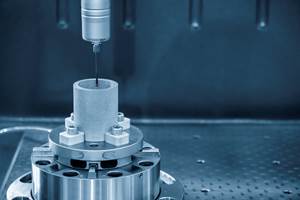Assessing Gage Stability
Gage stability implies different things in different contexts. If taken literally, it may refer to whether there is something loose on the gage, or some other gage problem occurs randomly, to cause two identical trials to produce different results.
Share





Gage stability implies different things in different contexts. If taken literally, it may refer to whether there is something loose on the gage, or some other gage problem occurs randomly, to cause two identical trials to produce different results. When plotted on a histogram, this type of instability shows up as a distortion of the expected bell-curve shape—perhaps in the form of dual modes (i.e., high points) with a dip in between, or in a mode that is skewed toward one end of the tolerance range or the other.
Other types of stability are best assessed and visualized through the use of control charts, in which measurements of several small lots, each represented by a histogram, are compared over a period of time. A single, certified master or other qualified part should be used for the entire series of repeated trials. This serves to eliminate part-to-part error as a variable, so remaining variation will likely be low. Nevertheless, testing may show that variation between lots becomes significant enough over an extended period so as to constitute a measurement problem.
"Statistical stability" refers to the consistency of the measuring system's performance from lot to lot. If a gage is statistically stable, each lot or histogram will be nearly identical in shape and range (R), and the average value (X-bar) of subsequent lots will be close to one another. If it is statistically unstable, the histograms will vary in terms of their X-bar or R values, or both.
Figure 1 shows statistical instability of both sorts. The histograms vary considerably in their ranges and shapes, while the mean dimensions are clearly irregular from lot to lot.
"Long-term" and "short-term" stability are confusing, because both require a long-term effort to assess. Both describe trends in the X-bar or R values across multiple lots. If we were to draw a line connecting the X-bar value of each histogram in Figure 1, we would observe no clear trend. Thus, we cannot make a meaningful assessment of either long- or short-term stability.
In Figure 2, the R values are nearly identical, and the X-bar values are grouped much more closely, so the gage is statistically stable. A line connecting the X-bar values would show a clear trend along the nominal value, so we have good long-term stability. This chart shows realistically how the performance of a good, stable gage looks.
Figures 3 and 4 both show good statistical stability. But in Figure 3, there is a short-term stability problem, with a bias in the plus direction. After a few sets of trials, however, the measurements become stable and remain so over the long term. The problem may be due to a warm-up condition in the gage itself. Or it might be the result of contamination that has settled on the gage over night. The X-bar value shifts as the contaminant is dispersed, due to mechanical interaction between the gage and the samples being measured. After a few dozen trials, all the contaminant is dispersed and the measurements become stable.
Figure 4 illustrates the opposite situation. The gage is stable on startup and over the short term, but over the longer term it becomes unstable as the X-bar values begin to drift upward. This might be the result of external thermal influences. If performance were to be charted over a longer period, the X-bar values might drift back toward nominal again; this might indicate the gage is responding as the plant warms up in the morning, then cools down toward evening.
It is important to check gages for stability, in order to avoid making inappropriate adjustments to the manufacturing process. In some cases, solving the problem may be as simple as establishing a more frequent schedule for remastering the gage. In others, it could require a reevaluation of the entire gaging process.
Related Content
Parts and Programs: Setup for Success
Tips for program and work setups that can simplify adjustments and troubleshooting.
Read MoreTurning Fixed-Body Plug Gages Inside Out
Fixed-body mechanical plug gages provide fast, high-performance measurement for tight-tolerance holes.
Read MoreProcess Control — Leveraging Machine Shop Connectivity in Real Time
Renishaw Central, the company’s new end-to-end process control software, offers a new methodology for producing families of parts through actionable data.
Read MoreThe Link Between CNC Process Control and Powertrain Warranties
Ever since inventing the touch-trigger probe in 1972, Sir David McMurtry and his company Renishaw have been focused on achieving process control over its own manufacturing operations. That journey has had sweeping consequences for manufacturing at large.
Read MoreRead Next
Machine Shop MBA
Making Chips and 91ÊÓƵÍøÕ¾ÎÛ are teaming up for a new podcast series called Machine Shop MBA—designed to help manufacturers measure their success against the industry’s best. Through the lens of the Top Shops benchmarking program, the series explores the KPIs that set high-performing shops apart, from machine utilization and first-pass yield to employee engagement and revenue per employee.
Read MoreAMRs Are Moving Into Manufacturing: 4 Considerations for Implementation
AMRs can provide a flexible, easy-to-use automation platform so long as manufacturers choose a suitable task and prepare their facilities.
Read More


















